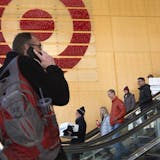If you'd asked me before Friday, I would have said there was no wrong way to decorate a Christmas tree.
"Hold my beer," said somebody in Minneapolis' Fourth Police Precinct.
Then they shoved that smelly beer can into the precinct Christmas tree, right next to a grubby pack of cigarettes and an empty cup from a fried chicken joint. Merry Christmas, North Side! We made you a Garbage Tree.
Minneapolis Mayor Jacob Frey is threatening to fire the officers responsible for decking the halls with trash and racist stereotypes and further eroding the trust between a neighborhood and the police force that's supposed to protect, serve and respect them.
Some people look at the twinkling lights of a Christmas tree and think: "I bet I could DIY that symbol of peace and joy into something truly awful."
Others look those twinkling lights and think: "You know, it's been a really rough year for this community. I bet I could DIY a little holiday hope and cheer."
You'll find good folk decking the halls in places like Barron, Wis. — a small town that's been in the news for the worst of reasons.
It's been a month and a half since 13-year-old Jayme Closs went missing. There's no sign of her and no good leads about what might have happened early in the morning of Oct. 15, when her parents, James and Denise, were shot dead in their home and Jayme vanished.



